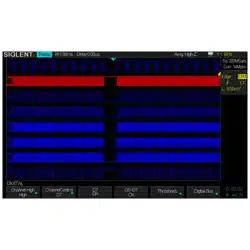Loading ...
Loading ...
Loading ...

SIGLENT
SDS2000X User Manual 145
To Set Color Display
Color temperature mode uses the change of the waveforms’ color to reflect the change of
the waveforms’ appearing probability. This mode uses a change in color instead of the
more common change in intensity. The greater the probability that the waveform appears,
the warmer the color is; the smaller the probability that the waveform appears, the colder
the color is.
The picture below shows the change of color from cold to warm. Press the Display button
on the front panel, and then press the Color softkey and set the option to On to turn on
the color temperature function. You can compare the waveform’s color with the picture
below to just the probability that the waveform appears.
Cold Color Warm Color
Figure 83: Color Temperature
To Set and Clear Persistence
With persistence, the oscilloscope updates the display with new acquisitions, but does not
immediately erase the results of previous acquisitions. All previous acquisitions are
displayed with reduced intensity. New acquisitions are shown in their normal color with
normal intensity. This mode is useful for capturing infrequent events and spurious signals.
Do the following steps to set and clear persistence:
1. Press the Display/Persist button on the front panel to enter the DISPLAY function
menu.
2. Press the Persist softkey; then turn the Universal Knob to select the desires option.
Off—turn of persistence.
Variable persistence time (1 second, 5 seconds, 10 seconds, 30 seconds ) —
Sets the persistence time. The results of previous acquisitions are erased after
the set time expires
Infinite—select “Infinite” Results of previous acquisitions are never erased. Use
infinite persistence to measure noise and jitter, to see the worst-case extremes of
varying waveforms, to look for timing violations, or to capture events that occur
infrequently.
Loading ...
Loading ...
Loading ...
